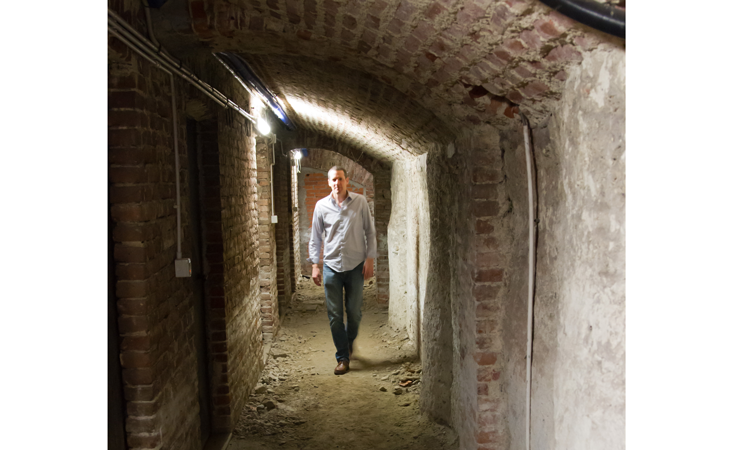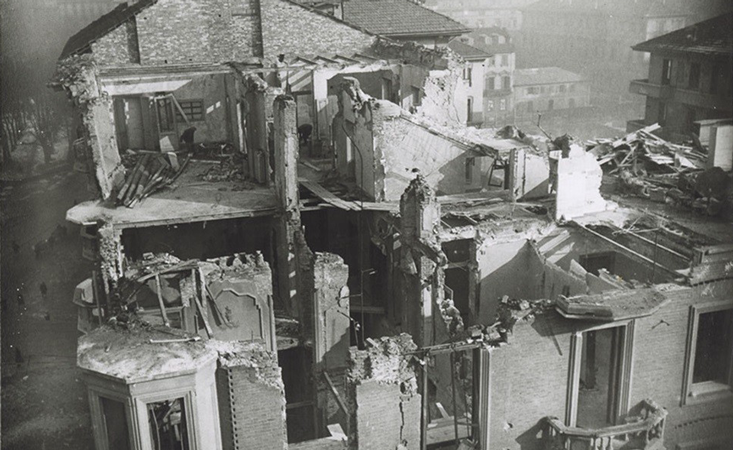On a cold, dry Tuesday in December, 1940, Rita Levi-Montalcini rode a train from the station near her home in Turin, Italy, for 80 miles to Milan to buy a microscope. Milan had not seen bombings for months. On her return to the Turin train station, two police officers stopped her and demanded to see inside the cake-sized box that she was carrying. With wartime food rationing, panettone cakes were only available illegally. The officers found her new microscope instead. They let her go. Just a week after her trip, British bombers hit Milan.
Levi-Montalcini was a 31-year-old scientist who had been working at the University of Turin. Despite her father’s disapproval, she had trained in medicine, inspired by seeing a nanny succumb to cancer. In 1938, the Italian dictator Mussolini banned Jews from positions in universities. Levi-Montalcini was not raised in the Jewish religion, but her Jewish ancestry would have been evident from her surname. Mussolini’s ban had pushed Levi-Montalcini to leave Italy for Belgium in 1939, where she did research using fertilized chicken eggs as a source of material for her research topic: the developing nervous systems of vertebrate embryos. Levi-Montalcini also spent time with her older sister Nina, whose family was in Belgium as well. Rita wrote home to her mother of an “infinite desire to embrace you again,” but research at the university in Turin would have been impossible had she returned home. Her passion for research alternated with her frustration with challenges. When Hitler invaded Poland in September, launching war, her worst frustrations were realized. The “whole world was in danger,” Levi-Montalcini later wrote. In December 1939, she returned to Italy.

Levi-Montalcini moved in with her mother, her twin sister Paola, who was an artist, and her architect brother Gino, in her childhood home. The apartment, in the center of Turin, was large, with 10 rooms, including a bedroom for each family member and a common living room. Some of the rooms faced into the apartment building’s common courtyard. There was little for Levi-Montalcini and her family to do outside of the apartment; Mussolini’s laws restricted Jews from most jobs and schools and threatened to confiscate Jewish-owned property. A fascist manifesto asserted that Jews do not belong to the Italian race, and declared, contrary to popular sentiment in Italy, “It is time that Italians proclaim themselves genuinely racist.” In June 1940, Mussolini joined Hitler by declaring war on France and Great Britain, and Britain responded with nighttime aerial bombings of Italy through summer and fall, focused on Turin and other industrial cities. The city was dark each night as a blackout was enforced across Italy. No lights were permitted to be visible from homes or shops.
Levi-Montalcini responded to the tumult by transforming her bedroom into her own research lab. The bedroom was long and narrow, and opposite its entrance was a window, which overlooked the courtyard. In front of the window, she placed a table for opening eggs and a simple microscope for operating on the embryos. Near her bed she placed the more elaborate microscope that she carried from Milan, a new model with two eyepieces so she could look into it with both eyes. It was equipped with a camera, and a device with mirrors that would allow her to see both microscopic detail and her own hand next to the microscope at the same time, so she could trace on paper the tiny nerve cells that she viewed. The bed was against one of the long walls, and at the opposite wall she put shelves, on which sat a heater for melting wax, and an egg incubator that her brother built with a thermostat and a fan. She could embed embryos in the melted wax which, once hardened, she would cut into paper-thin slivers, so that she could view nerve cells in the slices in the microscope from Milan. The experiments “absorbed her completely,” she later recalled, satisfying a childhood dream to explore unknown places, in this case the “jungle” of the nervous system.
I sought to walk in Rita Levi-Montalcini’s footsteps to build a clearer sense of what life was like for her.
Today, few people—even very few scientists—know what it was that Levi-Montalcini uncovered in her bedroom lab in Turin. Textbooks cite her courage but rarely her wartime discoveries, which are usually credited to others. Levi-Montalcini earned a Nobel Prize for scientific accomplishments that she made after the war. But when she died in 2012, at age 103, she left behind only a little writing about her experiences during the war, along with some rarely read technical articles from the time, published in Italian and French.
I had read Levi-Montalcini’s autobiography, In Praise of Imperfection, but it divulged little about her research during the war or about what she experienced at the time. I found her research articles from the time and began to translate them to English, to pore through the details of her discoveries. In 2018, on a work trip to nearby Switzerland, I contacted Levi-Montalcini’s closest living relative—her niece Piera Levi-Montalcini—who agreed to meet with me and talk. I sought to walk in Rita Levi-Montalcini’s footsteps in Italy to build a clearer sense of what life was like for her when she was making discoveries in the midst of a war.
As I reconstructed her experiences, her research articles from the war revealed to me that the experiments from her bedroom were more pivotal than I’d expected based on textbooks. Levi-Montalcini’s wartime experiments asked something fundamental. How do our billions of nerve cells wire up so precisely inside our bodies? Her bedroom discoveries charted a new course for humankind’s understanding of how our nerves connect, allowing us to walk and see and feel.
When you were an embryo, nerve cells shaped like long, thin wires snaked throughout your body, connecting your brain and spinal cord to many targets—to the muscles that each nerve cell will control, for example. Imagine your body as a house under construction, but where the wires grow themselves out from the central circuit box, winding through the walls, and connecting to each outlet, appliance, and light bulb. A human body is more complex than a house, so you’ll need to imagine a house with not dozens of wires, but billions. How can each wire locate each target, making accurate connections in your body—billions of accurate connections—and all while your tiny fetal body is growing and changing shape? Getting wires to connect to all these targets is a formidable task. And miswiring can lead to paralysis. There are birth defects in which babies are born permanently unable to smile, or to walk, because certain nerve cells fail to connect to targets.
Levi-Montalcini had a lifelong obsession with understanding how our nervous system develops. And, in the summer of 1940, she had what she called her “conversion.” She was reading an article by Viktor Hamburger, a German working in the United States exploring how nerve cells develop. She read the article as she sat on the floor of an open train car moving slowly through the countryside, enjoying a backdrop of yellowing corn plants and bright red poppies.
Hamburger’s article described his experiments aimed at understanding how nerve cells connect accurately. Hamburger’s goal in the experiments was to remove some targets—the muscles that some nerve cells would wire up to the brain—to learn whether nerve cells grow differently if deprived of targets. He did his work in chicken eggs—nerves in chicken embryos develop much as they do in humans, and using eggs ensured a plentiful source of material for his experiments.
Today very few scientists know what it was that Levi-Montalcini uncovered in her bedroom lab in Turin.
Hamburger described carefully cutting a window in an eggshell at a stage when the chick embryo inside was only about the size and shape of a typed letter “f,” but translucent and nearly invisible on the surface of the yolk. Near the middle of the “f” were two bumps that would normally grow to become wings, at least in fertilized chicken eggs that are not eaten. Hamburger used a glass needle under a microscope to remove one bump—the wing bud on the right side. And about five days after the operation, he examined nine eggs to see the effect of depriving the nerve cells of their targets. He saw that in each egg, the normal wing bud on the left side had grown to a few millimeters long, and nerve cells had grown out to it as expected. But on the right side, where he had removed the wing bud, the nerve cells were missing.
Hamburger surmised that in the absence of targets, the nerve cells had never formed. He speculated that normally, the target muscles must somehow send a signal that can induce other cells to become nerve cells, or perhaps cause young nerve cells to divide, making more nerve cells. In the article he noted a long line of earlier researchers whose experiments or observations of birth defects—in humans or animals—revealed that the number of nerve cells would match roughly the number of targets. Loss of a limb would result in fewer nerve cells found nearby. And increasing the target population would result in more nerve cells nearby. Hamburger’s interpretation suggested a simple solution to how this match was made: Each muscle somehow turns other cells nearby into nerve cells, guaranteeing that a population of nerve cells would be available locally to connect to each muscle.
Levi-Montalcini was struck by the clarity of Hamburger’s writing. By this stage she had trained in Turin with the famous neurobiologist Giuseppe Levi (who only coincidentally shared a surname with her), worked in Belgian labs, and published nine scientific articles reporting new discoveries. She had worked with chick embryos, with mice, and with microsurgery, and she had observed detailed nerve and muscle anatomy. She was an experienced researcher who was well equipped to take some next steps to understand how nerve cells make accurate connections to their targets.

After the aerial bombings began in 1940, Levi-Montalcini could work all day in her bedroom lab. At night, when sirens announced incoming warplanes, Levi-Montalcini and her family would hurry out of their apartment, down a set of stairs, and then across the courtyard to another set of stairs that led to cellars. Levi-Montalcini would bring her microscope and precious glass slides with her. Families would wait for hours in the cellars and hope they would not be buried in rubble.
Levi-Montalcini must have left the apartment frequently to buy chicken eggs for the experiments, at times likely walking among bomb rubble. She repeated the experiment that Hamburger had described, removing a tiny limb bud from each chicken embryo and examining the effect on nerve cells later. Hamburger had used a glass needle to cut out the tiny limb bud; in place of a glass needle, Levi-Montalcini used an ordinary sewing needle that she had sharpened. But Levi-Montalcini also decided to do something new: To see how the embryos developed, she examined the results of the operation each day after removing the limb bud. This required embedding one embryo in wax each day, then slicing the wax, observing the slices on glass slides under the microscope, and counting thousands of nerve cells. Her patience with the experiments would allow her to see how development proceeded little by little after removing a limb bud—like watching a movie made from individual frames—instead of seeing only a single moment in time as others had before her. She also used a silver stain and a blue dye to see the nerve cells more clearly than before, allowing her to distinguish young nerve cells from fully formed ones. And she used a red dye that could highlight dividing cells. She recorded counts of thousands of nerve cells nearly every day from 2 to 19 days after removing a limb bud.
In August, 1941, Levi-Montalcini’s mentor Giuseppe Levi joined her and began to assist with her experiments. Levi had moved to Belgium too and had been working alone in an empty Belgian institute for a year after the Germans invaded. He arrived thin and pale after a difficult trip across Germany. Levi-Montalcini’s bedroom lab became a meeting place where Levi’s friends and former students would visit and talk about the events in the news.
In the chicken embryos, Levi-Montalcini saw what Hamburger had seen about five days after the operation: There were fewer nerve cells on the side of the embryo where the limb bud had been removed. But following this day-by-day revealed to Levi-Montalcini something unexpected.
For the first two days after removing a limb bud, the areas where nerve cells would form looked surprisingly similar on both sides of the embryo. Nerve cells did not fail to form—they were forming in the thousands on both the normal side and the operated side. On the third day after the operation, nerve cells continued to form: Levi-Montalcini saw dividing cells on both sides. Young nerve cells had accumulated as well as more fully formed ones. Only then did she begin to notice slightly fewer of the fully formed nerve cells on the operated side. Peering in the tiny wax slices at embryos on each successive day made clear that nerve cells continued to form after removing a limb bud. But then soon after forming and extending out toward targets, the nerve cells that were deprived of targets would disappear. Only nerve cells that contacted nearby targets, like in the skin along the back, remained.
How were the nerve cells disappearing? In her bedroom lab, Levi-Montalcini saw something that other scientists had not predicted. The nerve cells deprived of targets appeared to be dying after reaching toward targets in vain. In the areas where nerve cells were disappearing, Levi-Montalcini could see signs of nerve cell death—she reported abnormally “conglutinated” masses of nerve cell fibers, and a shrunken nucleus in many of the cells. Dying nerve cells had been described in animal embryos before by others, but what Levi-Montalcini saw was the first sign that nerve cells would die specifically when they lacked targets. Imagine removing a light bulb from a house under construction, and watching as wires snaked through the walls, reaching everywhere—but then shriveling up specifically where they failed to find the missing bulb.
Textbooks nearly always credit what Levi-Montalcini discovered during the war to other scientists.
Levi-Montalcini sent the results for publication in a scientific journal in Belgium—Jewish scientists were barred from publishing in Italian journals. In the article, published in French in 1942, she and Levi reported the discovery: Nerve cells that were deprived of targets formed normally, but then disappeared. Near the end of the article was a promise to better document how exactly the cells were disappearing: “We propose to do this in a more detailed presentation and with more documented results.” But British bombings of Turin intensified that fall. In hindsight, there was no guarantee that Levi-Montalcini or her bedroom lab would have survived to fulfill her promise.
Levi-Montalcini continued to observe her sectioned embryos, in essence replaying the film of nerve cells disappearing but looking more closely at the details of the disappearance. After documenting for herself what she saw, she prepared an article in Italian for a Vatican journal, again evading the ban on publishing in Italian journals. As the earlier article had promised, this one was indeed packed with detail—descriptions of a microscopic world of nerve cells in the throes of death before they vanished near where their targets had been removed. Granules organized in neat stripes had disappeared from the insides of dying cells, and the shrinking nucleus of each dying cell had material that was abnormally organized inside, surrounded at times by only “a thin and pale cytoplasmic veil.” Levi-Montalcini described the details of death in all sorts of nerve cells that are common to chicken or human embryos, from nerve cells that convey to our brains what our extremities feel, to others that allow our toes to move. The research article had 45 pages of detail, including seven pages of photographs and drawings. If there was some doubt left after the earlier paper that nerve cells deprived of targets would die, this next article had settled it.
These two articles charted a new course for understanding how our nervous system is shaped. Cell death sculpts our nervous system: Our brain becomes wired to our body so precisely in large part because those nerve cells that fail to find targets simply die.
In October, 1942, the nighttime bombings of Turin resumed after a seven-month lull. One Thursday night, sirens started near 9 p.m. and sounded for more than three hours, as bombs fell from British planes heading southeast to a coastal city. The next night, the sirens started just after 10 p.m., sounding for more than two hours. The bombings intensified in November. On some nights, nearly 200 planes flew over Turin, dropping hundreds of tons of bombs. Bombs and devices to start fires hit industrial sites, homes, theaters, and hospitals. Hundreds of Turin residents were killed. A Turin resident described in his diary seeing in the mornings the “astonished, amazed faces of the people who wander the streets” surveying the damage from the night before. The strategy of hiding in cellars was abandoned for many citizens of Turin, as they began to evacuate the city en masse. Levi-Montalcini and her family moved to a family farmhouse in the countryside, near the town of Asti.
It was a bright Saturday in April, 2018, when I arrived in Turin. I made my way to a boulevard shaded by horse chestnut trees vying for height and grandeur with ornate, five-story apartments. I admired the carvings on the 12-foot-tall wooden doors. This was Rita Levi-Montalcini’s apartment building. I pushed on the doors, but they were locked. Behind them was the courtyard that was Levi-Montalcini’s view from her window. A woman with her son walked out of the front of the building. After some hesitation, she let me walk back in with them. I passed through a short, covered walkway to the grassy courtyard, which was surrounded by five floors of windows and doors and narrow balconies. The woman had met Levi-Montalcini before, “many times,” she said with a smile. She was Levi-Montalcini’s grand-niece—the daughter of Piera. In a café behind the apartment, I found stairs that led to the cellars where families would hide during the bombings. The cellars were apparently unchanged since the war. I walked on dry dirt and scattered rocks along a narrow passageway of roughly mortared brick walls and old wooden doors, each with a hand-painted number and a small window of metal mesh.
The next day, I drove to Asti, an hour away. I checked into a hotel and walked through town past medieval churches and busy outdoor cafes. On the following day, Gino Montalcini—a cousin of Piera’s who now owns the farmhouse where Levi-Montalcini and her family went in 1942—took me in his car out of the center of town, to the top of a nearby ridge where the house sits. I met Piera, and Gino’s wife, Anna.

Piera, who was Rita’s frequent travel companion late in Rita’s life, bore some resemblance to the Rita I’d seen in photos. They shared an upswept, styled volume of white hair. Piera also shared some of the unconcerned confidence that Levi-Montalcini had while working in a male-dominated field. Piera was an electrical engineer. “If you just walk your own way and you are brave enough—I mean, reckless enough— they look at you as if you were an alien, so they stay away from you,” Piera said with a smile. When she was choosing a career path in the 1960s, Piera visited Rita, who at the time had a lab in Rome. She recalled Levi-Montalcini’s thin hands, the chick embryos, and seeing one of the needles that Levi-Montalcini used, “They appear enormous when viewed through the microscope!”
Behind the house sat a green lawn shaded by a row of linden trees. From the lawn I could see the town below, and the tracks on which the trains came from Turin. Asti was not a frequent target for bombings when Levi-Montalcini was there, but sirens announced British warplane flyovers. A mid-July 1943 nighttime bombing in town probably would have been visible from the house.
I walked to a high spot on a corner of the property, and Gino Montalcini pointed along a path toward a neighbor’s house where Levi-Montalcini stayed when the farmhouse was filled with the extended family. Levi-Montalcini would have walked to the farmhouse each morning along the path, past grape vines, a few cows, goats, and sheep, and some chickens. She relocated her microscope and the other lab equipment from Turin in front of a window in a corner of the dining room. Here she worked through the fall of 1943, when it became unsafe.
I asked how Levi-Montalcini maintained her focus during war. Her niece said she “kept working to survive.”
We went inside and sat down in the dining room. We were just an arm’s length from where Levi-Montalcini would have sat at her microscope. Piera told us, “I think of all the things we often did together. I have memories of the places we’ve been together, the things she would tell me about her life. When she was traveling with me, she knew that I would listen if she wanted to talk, and that if she didn’t feel like talking, she just didn’t have to.” Piera smiled and recalled that Rita would tell her, “‘You’ve always been my best travel companion.’ Because I didn’t bother her, basically.”
I asked Piera how she thought that Levi-Montalcini could have maintained her focus on research in the midst of a war, studying cell death while in real danger of her own death. She said that Levi-Montalcini “kept working to survive, to cope with that weird life of people who didn’t exist. Because they had been erased everywhere.”
Piera recently discovered the letters that Rita and her sister Nina had sent home from Belgium in 1939 soon after the war had begun, while they had waited for visas to return home. The letters elaborate on how Rita maintained her focus on research as a war began around her, describing the escape from despair that her research offered as the war began. Rita wrote, “I am amazed at the complete possibility of escaping to the present, diving into the marvelous charms of nerve conduction.” Nina added in the margins that her younger sister Rita, “here reading next to me … is so well … she is so animated for her studies.”
Back home, in my lab at the University of North Carolina at Chapel Hill, I searched for any signs in Levi-Montalcini’s wartime research articles that the experiments took place in a bedroom. As was typical in scientific articles, the writing focused tightly on the experiments and their results. Levi-Montalcini didn’t mention her home, or the sewing needle that she had used for microsurgery. I could find only one cryptic clue, in the 1942 article, that the site of the work might have been atypical. Every other scientific article in the 1942 volume included the name of the institute where the work was performed. “University of Brussels, Laboratory of Embryology of the Faculty of Medicine.” “University of Liege, Laboratory of Histology.” Levi-Montalcini’s article listed just one word for the address, “Turin.” No institute. I wondered if scientists reading the article in 1942 might have noticed the peculiar omission.
Viktor Hamburger saw the 1942 article after the war ended. Levi-Montalcini’s results confirmed to Hamburger what he had seen earlier—that targets could affect how many nerve cells would be nearby. But they also showed that Hamburger’s speculations about how this worked were wrong. He invited her to come to the United States to continue the experiments in his lab at Washington University in St. Louis. There, Levi-Montalcini discovered that even in normal, unoperated embryos, many nerve cells die where they lack targets—for example in the areas where no limbs form. And the nerve cells that would die in normal embryos could be rescued—they would survive if targets were added nearby, confirming that even in normal development, many nerve cells form but die because they lack targets. Hamburger was clear about his own limited role in this work. He contributed his thoughts and his enthusiasm for Levi-Montalcini’s results, but, as he reported later, “the experiments and observations on the slides were done by Dr. Levi-Montalcini.” And he accepted that the results proved him wrong. “It was a regressive process rather than a progressive process as I had guessed, wrongly,” he reported in an interview. Levi-Montalcini recalled later what she called one of Hamburger’s finest traits, his “whole-hearted joy over fortunate turns in a colleague’s or pupil’s research.”
In the warm evenings of summer 1948, Levi-Montalcini would share dinner with Hamburger and his aged father, and then sit at a table under the porch in St. Louis as they wrote an article describing the results. Levi-Montalcini had published more than 20 research articles by this time, but none in English. That summer, she wrote of her pleasure of re-experiencing the clear thinking in Hamburger’s writing years earlier. Just a mile from where they met in the evenings of summer, 1948, Levi-Montalcini now has a star on the sidewalk in the St. Louis Walk of Fame, along with Chuck Berry, Stan Musial, Maya Angelou, and others.
Levi-Montalcini’s experiments in the 1940s revealed that our brain and spinal cord manage to make connections all over our body because our embryonic bodies become densely filled with an excess of nerve cells—about a twofold excess, scientists now estimate. Those nerve cells that make accurate connections are afforded the privilege of survival. The rest die. The process seems remarkably inefficient, but it is remarkably robust: Birth defects where connections are not made are rare. Even if you were born with an extra body part, it would almost certainly become wired up to your brain. Indeed, people born with an extra finger or toe can generally attest to this: Their brains can move the extra part, and feel using it. And vertebrate animals of all different sizes and shapes no doubt have nervous systems that fit their bodies in large part because of this process. Levi-Montalcini’s bedroom discoveries were the turning point in humankind’s understanding that our nervous system is minutely shaped by death. Cell death is not alone in shaping the nervous system—later scientists discovered that other processes make important contributions as well. And cell death has more complex roles than had been revealed by the end of the 1940s. But Levi-Montalcini’s experiments established a fundamental finding about how our nervous system is shaped.
Nearly every textbook today on the development of the nervous system has a chapter on cell death’s prominent role in wiring our bodies. Some of them note Levi-Montalcini’s courage for doing experiments in a homemade lab during the war. What she discovered in the war, though, is today nearly always credited to other scientists. One book credits a scientist working in the 1930s, who did not report on cell death at all. Others credit Hamburger. Some cite Levi-Montalcini only for guessing that nerve cells lacking targets might die, crediting Hamburger and Levi-Montalcini working together in 1949 to first show it definitively—years after Levi-Montalcini had shown it in the articles she wrote from her bedroom lab. It perhaps did not help that Hamburger and Levi-Montalcini themselves had muddied the history of the discoveries over the years. They each lived beyond their 100th birthdays, and both made statements about their roles at times, particularly late in their lives, that did not precisely match the published record.
I contacted scientists who wrote the textbooks to ensure I had my facts straight. Dale Purves, author of the book Body and Brain, told me that he had never read Levi-Montalcini’s wartime research articles. Dan Sanes, who co-wrote the textbook Development of the Nervous System, said the same. Lynne Bianchi, Bill Harris, David Price—none of the textbook writers I reached had read the articles. I find it hard to place blame, really. English has become the international language of science in recent decades, even at international conferences, and the wartime articles were published in Italian and French. My translations benefitted from Google Translate, which improved after the textbooks were first written. And textbooks cover a lot of ground—thousands of research papers. “You know there’s only so many hours,” Price explained, adding an invitation to correct the record. “I’d love to get it right in my head. And then in the book.”
I offered to share the translations of Levi-Montalcini’s wartime papers with the writers. And based on the translations, it was clear to me that among a muddied record was a detailed historical article by another scientist, Maxwell Cowan, who had read each of the papers and who had the facts straight. I shared that article as well. Some of the writers reached back to say they were already drafting corrections for the next edition of their textbook. Their responses reminded me of Hamburger’s enthusiasm about Levi-Montalcini disproving his own hypotheses. When new facts came to light, he accepted them. Purves, who knew Hamburger, said about Levi-Montalcini’s wartime science, “These were remarkable times, and she was a remarkably resilient person.”
From the time Levi-Montalcini arrived at Washington University, she continued to build on her research during the war: how target tissues like muscles talk to nerve cells, enabling the survival of only those nerve cells that find targets. That led to her co-discovery with Stanley Cohen of Nerve Growth Factor—a molecule that nerve cells take up from target tissues and that enables the nerve cells to survive. Nerve Growth Factor was the first of several growth factors discovered by scientists, and these factors are now known to have critical roles in nervous system wiring and also in cancer. In 1986, Levi-Montalcini and Cohen were awarded the Nobel Prize in Physiology or Medicine for their discovery of growth factors.
Throughout her life, Levi-Montalcini denied that she had experienced discrimination as a woman in science. Her colleagues, though, recall her fiercely defending her own role in her discoveries. After the Nobel Prize, she established a foundation to provide scholarships to African women, and she was made a Senator for Life in the Italian Parliament in 2001. Fifty years after her 1942 article reporting experiments from the bedroom in Turin, she reflected on how she managed to focus on her research in the midst of a war, “when all the values I cherished were being crushed.” She wrote, “The answer may be found in the well-known refusal of human beings to accept reality at its face value, whether it be the fate of an individual, of a country, or of the whole of human society. Without this built-in defense mechanism, life would be unbearable.”
Bob Goldstein heads a biology research lab at the University of North Carolina at Chapel Hill.
Lead collage: Tasnuva Elahi; photo by AP Images; tracings of nerve cells by Rita Levi-Montalcini, made in her home lab.























